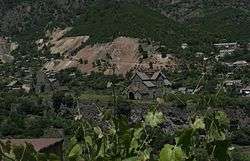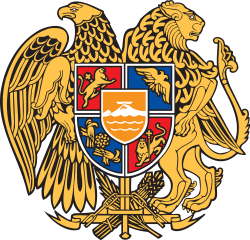Akhtala
- For the town in Kotayk Province, see Lorri; for the nearby village sometimes also called Akhtala, see Verin Akhtala, Akhtala (disambiguation).
Coordinates: 41°08′40″N 44°46′29″E / 41.14444°N 44.77472°E
| Akhtala Ախթալա | ||
|---|---|---|
|
Akhtala with the Monastery and the Fortress | ||
| ||
 Akhtala | ||
| Coordinates: 41°08′00″N 44°46′00″E / 41.13333°N 44.76667°E | ||
| Country | Armenia | |
| Province | Lori | |
| First mentioned | 18th century | |
| Government | ||
| • Mayor | Haykaz Khachikian | |
| Area | ||
| • Total | 4.3 km2 (1.7 sq mi) | |
| Elevation | 740 m (2,430 ft) | |
| Population (2011 census) | ||
| • Total | 2,092 | |
| • Density | 490/km2 (1,300/sq mi) | |
| Time zone | UTC+4 | |
| Website | Official website | |
| Sources: Population[1] | ||
Akhtala (Armenian: Ախթալա), is a town in the Lori Province of Armenia, located along the Shamlugh river, on the slopes of Lalvar mountain, at a distance of 186 km north of the capital Yerevan and 62 km north of provincial centre Vanadzor. Akhtala was a village until 1939 when it was granted the status of an urban community, with its 400 inhabitants. In 1995, the government of independent Armenia reaffirmed the status of Akhtala as a town. According to the 2009 official estimate, Akhtala has around 2,400 inhabitants. However, the town used to have around 4,500 inhabitants during the 1970s.
History

During the 18th century, the village known as Akhtala was part of the Borchalu region of Tiflis governorate under the Russian rule. Starting from 1763, Greek experts from Gümüşhane arrived in Akhtala by the request of King Erekle II of Georgia, to utilize the copper and silver mines and establish the copper and silver factory in Akhtala region. Therefore, the village was sometimes called "Pghindzahank" (copper mine) and "Artsatahank" (silver mine).
The ancient settlement of Akhtala is situated on the same territory of the present-day mining area of Akhtala. It is associated with the Tashir canton of Gugark province of the ancient Kingdom of Armenia. Archeological excavations showed that the area has been occupied by human since the early Bronze Age. The settlement of modern-day Akhtala was known as Agarak during the 5th century.[2][3] The half-ruined fortress of Akhtala is more than 1000 years old. It was built on top of Bronze and Iron Age foundations,[2] in the late 10th century by the Kyurikids, a branch of the Bagratunis originated from Gurgen (pronounced Kyurikeh in the local dialect of Gugark). He was the son of the patrons of Sanahin and Haghpat monasteries located not far from Akhtala, King Ashot III the Merciful and Queen Khosrovanush. Gurgen's brothers were King Smbat II the Conqueror and Gagik I Bagratuni, under whom the Bagratuni Kingdom of Armenia reached the peak of its prosperity.[4]
The Bagratuni King Smbat II of Armenia founded the Kingdom of Tashir-Dzoraget in Gugark for strategic reasons and enthroned his brother Kiurike I in 979.[5] Gurgen along with his brother Smbat are depicted on the sculptures of the patrons in both Sanahin and Haghpat. When the Tashir-Dzoraget kingdom fell as a result of the Seljuk raids, the Kyurikids migrated to Tavush and Metsnaberd, yet they maintained ties with their ancestral fortress and compound in Akhtala.
The impressive Akhtala monastery was reconstructed during the 13th century by prince Ivaneh Zakarian with a unique architectural style. This medieval Christian complex which is located inside the fortress, was one of the important educational centres in the historical province of Gugark.
Another significant architectural monument in Akhtala is the monastery of the Holy Trinity. During 1887-1889 excavations conducted by French archaeologist Jacques de Morgan, the site of a historical cemetery was unveiled with some bronze and iron objects, weapons, and ornaments dating back to the 8th century BC.[6]
The area of the modern-day Akhtala was previously known as Nerkin Akhtala. Currently, the town is commonly divided into 3 neighbourhoods:
- the original town located at the northwestern part, comprising the old village of Nerkin Akhtala.
- the new town located at the central and southern parts on a hill between the Debed river and its tributary Shamlugh.
- the eastern neighbourhood located on the shores of Debed river, to the east of the old town.
Geography
Being located in the valley of Debed river a ta height of 740 meters above sea level, Akhtala has a subtropical climate with cool and dry summers and mild winters. Annual precipitation reaches up to 600 mm.
Demographics
In 1970, Akhtala had 4,430 inhabitants, while it was 2,225 in the 2001 official census.
Culture
Currently, the community has 2 public education schools with a kindergarten, a house of culture, 2 libraries, a hotel and a hospital. The town is home to the "Akhtala" sanatorium.[7]
The main problems of the community are related with the reconstruction of the historical monuments and the environmental issues, such as the air and water pollution.
Economy
The area is rich with copper, lead and silver mines which are of industrial importance and are being utilized. The main industrial enterprise of the town is the "Akhtala Mining Plant" which is owned by the "Metal Prince" company. There are small manufacturing establishments in the town for food productions.
Gallery
- Akhtala
-

Looking towards the gate of the monastery at Akhtala
-

Akhtala monastery within the fortified walls of the fortress
-

Fresco at the monastery
-

The ruins of the Holy Trinity monastery
-

Akhtala town
References
- ↑ Lori
- 1 2 Ney, Rick; Rafael Torossian; Bella Karapetian (2005). "Lori marz" (.PDF). TourArmenia Travel Guide. TourArmenia. Archived (PDF) from the original on 16 October 2007. Retrieved 2007-10-07.
- ↑ Tadevosyan, Aghasi (2007). Historical Monuments of Armenia: Akhtala. Yerevan, Armenia: "Var" Center for Cultural Initiatives. ISBN 978-99941-2-070-3.
- ↑ Macler, F. Armenia, The Kingdom of the Bagratides. vol. IV. The Cambridge Ancient History. pp. 161–165.
- ↑ Redgate, Anne Elizabeth (2000). The Armenians (First ed.). Massachusetts: Blackwell Publishers Inc. pp. 225–26,258,261. ISBN 0-631-22037-2.
- ↑ Union of Communities of Armenia:city Akhtala (Lori)
- ↑ About Akhtala





